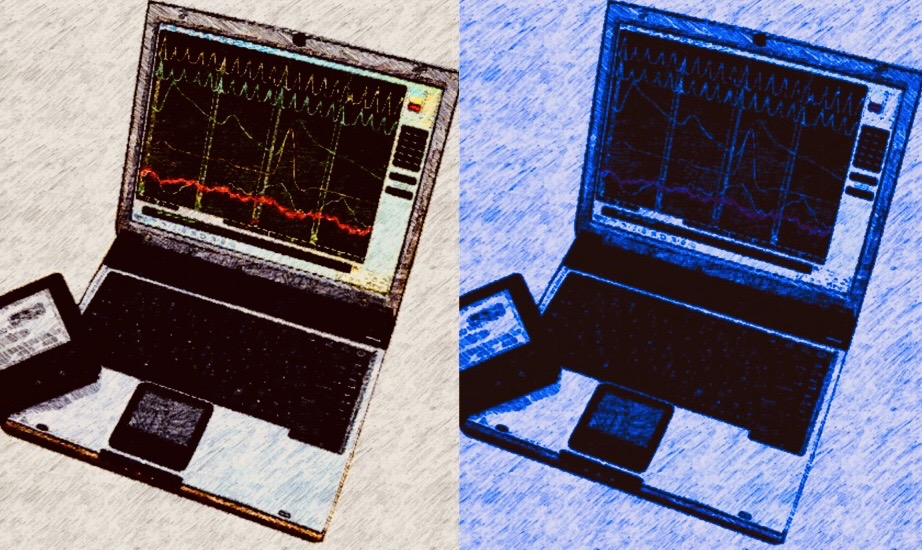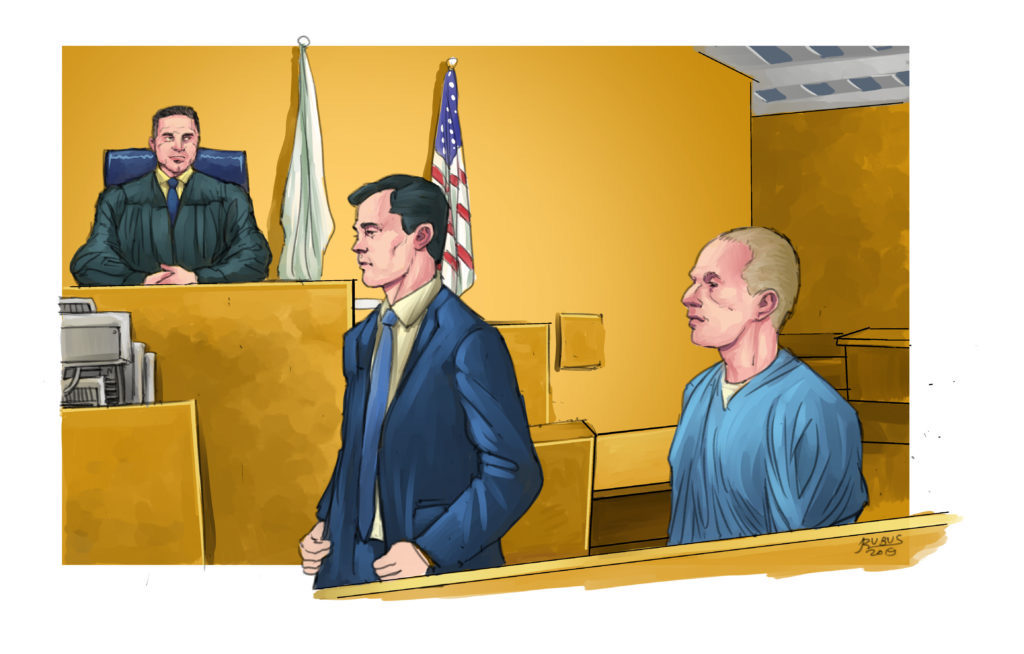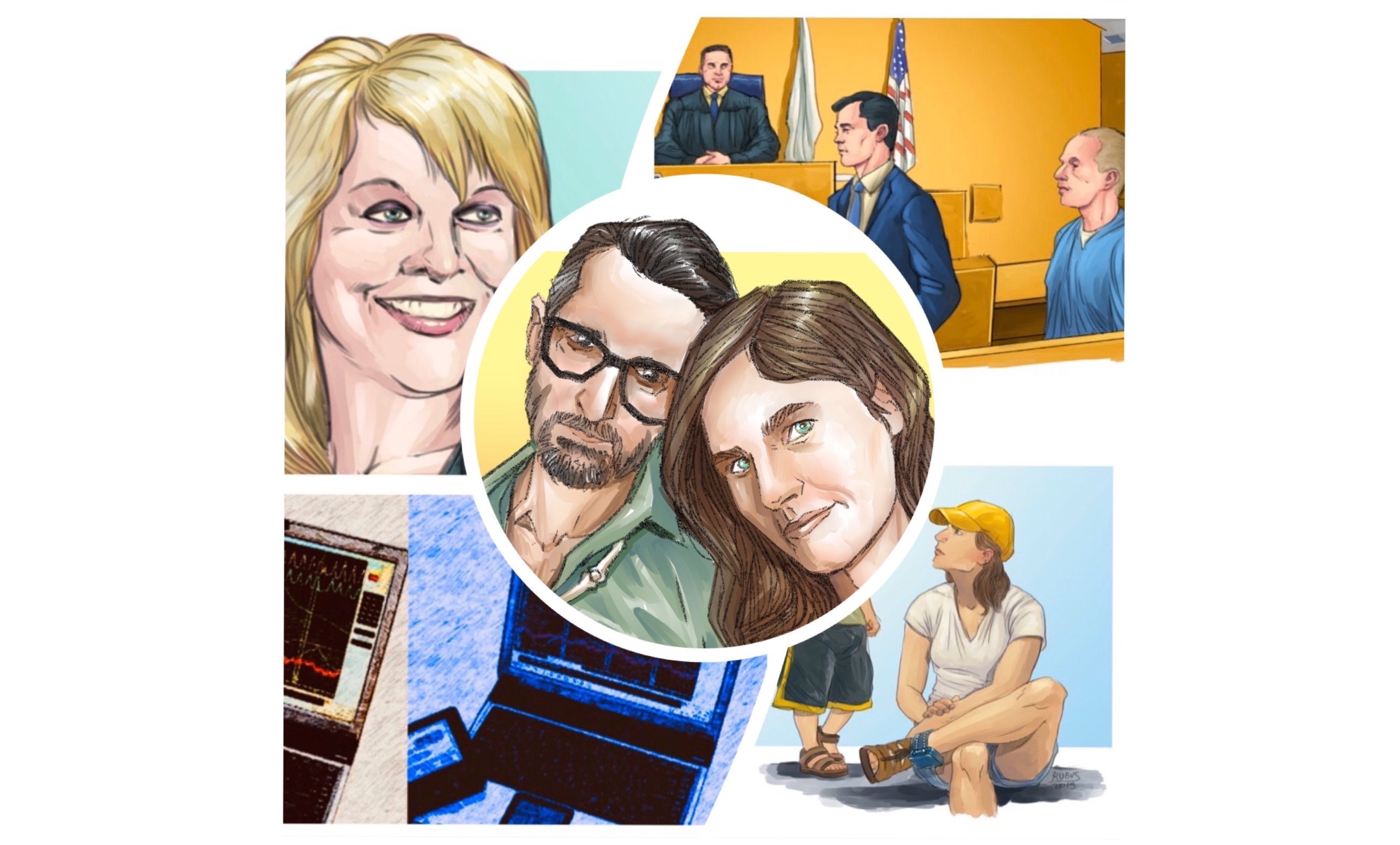Since August of last year, Amanda Knox with Christopher Robinson have contributed four pieces to Crime Story. Each offers a unique perspective on how our society approaches crime, justice and punishment. Today on The Crime Story Podcast we offer all four of those pieces in one presentation.

The Injustice of Nancy Grace
In Oxygen’s Injustice with Nancy Grace, Grace promises to investigate “cases that inspire other victims to believe it ain’t over yet. Somebody still cares.” In other words, Grace is reprising her self-appointed role of “voice of the victim,” and presumably ― Grace says the show will focus on wrongful accusations and botched investigations ― she’s finally including wrongly convicted people within that definition. If so, it’s a big step for Grace, who historically has treated people like me as monsters.
I first learned of Grace’s new show when Ryan Ferguson, a friend and fellow exoneree, tweeted, “Lol @oxygen, literally could not have chosen a worse person to discuss wrongful convictions. She, prosecutors like her, & that incompetent garbage she spews from her lips are the reason wrongful convictions happen. Akin to having child molester talk about why molestation is bad.”
Ryan spent 10 years in prison for a crime he didn’t commit. And like me, he got to experience injustice in the most personal way. Exonerees are some of the loudest advocates for due process and defendants’ rights. We have lived through the nightmare of a rush to judgment and a wrongful conviction, and we strive to ensure that others are spared that tragedy and trauma. Our shared experience has not only shaken our faith in the justice system, and undermined our trust that the law is fair; it has also given us unique insights into changes that need to occur. This exoneree community cares deeply about injustice, and we deeply distrust Nancy Grace with bearing that torch.
In his review of Grace’s 2004 book, Objection!, professor David E. Wilkes of the University of Georgia’s School of Law summarizes her modus operandi: she “relentlessly heaps scorn on, and endeavors to undermine, the constitutional protections afforded criminal defendants,” she “demonizes persons charged with crime,” and she “loathes and is incapable of understanding the indispensable role of the defense attorney in our criminal justice system.” In all her work, she “pop[s] off with shoot-from-the-hip condemnations and pronouncements without doing any research.”
Yep. That’s my experience.
It’s also been the experience of leaders within the innocence movement. I reached out to Justin Brooks, director of the California Innocence Project, for comment.
“I’ve had two experiences with Nancy Grace,” Brooks says. “One of them was 20 years ago when she was first starting out. We had this huge case in San Diego, the Westerfield trial, where this little girl was abducted in her bedroom and then was found out in the desert, murdered. Nancy Grace came to San Diego. She asked me to be on her show and I remember her calling for the death penalty for this guy who hadn’t yet been convicted of anything. It was just such reactionary nonsense.”
Brooks, by contrast, is against the death penalty. In his 30 years doing criminal defense work, he’s freed 30 innocent people from prison and reversed one unjust death sentence.
“My next experience was with one of my clients,” Brooks continues. “Ken Marsh had been exonerated and the San Diego district attorney agreed that he should be released from prison, but that evidently wasn’t enough for Nancy Grace. She still attacked him. On her show, she read from testimony at the preliminary hearing that had been disavowed and proven false. She’s not interested in details and facts. She just wants a sensationalized story. I’ve never taken her seriously as a news person. She’s the absolute wrong person for this show.”
Nancy Grace is a sensationalist, and she frequently has a tenuous relationship with facts. But the real reason she’s the wrong person for this moment is because she has a deeply problematic view of what injustice even is. The first episode of her new show illustrates this well.
It tells the story of the brutal murder of Grace’s friend, Pamela Vitale. Two-thirds of the episode is dedicated to rationalizing the investigators’ initial, erroneous focus on Vitale’s innocent husband, Daniel Horowitz (though Grace professes to have always believed in Horowitz’s innocence). The last third of the episode demonizes the actual murderer, 16-year-old Scott Dyleski.
In other words, she defends the mistakes made by investigators who targeted an innocent, bereaved husband and came ever so close to arresting him. And she demonizes as “pure evil” a 16-year-old who she would see locked away for the rest of his life without any hope for rehabilitation.
She has it exactly backwards. In a show titled Injustice, she should be critiquing the retributive instinct and hysteria that lead to a rush to judgment and prosecutorial overreach. She should be questioning the scope, motivations, and severity of our carceral state. Rather than endorsing the investigator’s notion that there is a “normal” way for the spouse of a murder victim to behave, she should be scrutinizing the investigative “tunnel vision” that she accepts as a necessity.
We need to be having a conversation about dismantling our retributive and ineffective system, and replacing it with models of restorative justice, championed by people like Jennifer Thompson. As a result of a faulty investigation and identification process, Jennifer mistakenly identified Ronald Cotton as the man who broke into her home and raped her. Ronald spent 11 years in prison for a crime he did not commit until DNA evidence exonerated him and identified the true rapist. After Ronald was released, Jennifer met with him and asked for his forgiveness. Exhibiting tremendous grace, he forgave her. The two of them wrote a book together called Picking Cotton: Our Memoir of Injustice and Redemption. Since then, Jennifer has been a tireless advocate for building relationships between offenders and victims and repairing the harm done by crime.
That’s what an inspiring “voice of the victim” sounds like. If Nancy Grace has been the voice of anything, she’s been the voice of unchecked outrage. And it’s done tremendous harm to the media landscape surrounding our justice system. But I believe people can change, can learn from their mistakes ― even Nancy Grace.
Showing compassion for victims is not mutually exclusive with upholding the presumption of innocence for the accused and the goal of rehabilitation for the guilty. I could not be more thrilled if Grace used this new show as an opportunity to finally learn this important lesson.

Expressions of Guilt
A young man is on trial for murder. His defense says he’s being railroaded. The prosecution paints him as a deceiving psychopath. Is he lying when he says he wasn’t there that night? We don’t have to look into his eyes to figure that out; the Emotion Recognition System does that for us. With dozens of cameras; thermal, pulse, and respiration measurements; sophisticated facial expression recognition algorithms, with billions of hours of human observation as background data; and thousands of hours of specific observation of this one defendant (from his time in police custody, from his social media accounts, subpoenaed from his home smart devices), the ERS is able to determine with 99% accuracy that he is lying.
This is speculation now, but it will be reality soon enough. Facial recognition technology is advancing quickly. Facebook’s DeepFace and Google’s FaceNet claim to have achieved near 100% recognition rates, outperforming human counterparts at the task of identifying faces that belong to the same person. Amazon’s cloud-based Rekognition API is already being used by law enforcement, notably the Orlando Police Department and the Washington County Sheriff’s office in Oregon. There are obvious concerns about privacy and the reliability of this technology; a test of Rekognition conducted by the American Civil Liberties Union incorrectly matched 28 members of congress to a database of mugshots.
And these concerns get a lot more complicated when emotion comes into play. That’s the next frontier. On August 12, Amazon put out a press release to announce Rekognition’s “improved accuracy for emotion detection.” This “sentiment analysis” is meant to detect “emotions that appear to be expressed on one’s face,” and they include “Happy,” “Sad,” “Angry,” “Surprised,” “Disgusted,” “Calm,” “Confused” and “Fear.” Despite the expected objections from poets and psychotherapists that there are surely more than eight emotions, there is an even deeper worry that Amazon rightly warns against: “the API is only making a determination of the physical appearance of a person’s face. It is not a determination of the person’s internal emotional state and should not be used in such a way. For example, a person pretending to have a sad face might not be sad emotionally.”
It’s tempting to read that last sentence and say, “duh.” But when you’ve been repeatedly told that your face reveals you to be a psychopath, it sounds like a much-needed caveat.
From the moment I was arrested, people began analyzing my smallest gestures and facial expressions, scouring for evidence of guilt. It continues to this day. Like this bit of pseudoscience claiming to be able to tell I’m lying in a Diane Sawyer interview. Or this post diagnosing when I cry and laugh, and concluding that I’m a manipulative psychopath. There are countless videos that attempt to analyze my body language, as if that could provide any reliable indication of deception or guilt.
I’m certain that people will be running footage of my interviews through emotion recognition algorithms before you know it. And it won’t just be me. The potential criminal justice uses for technology that senses emotion are manifold. Is this parole candidate showing true remorse? Is that witness certain or confused? Ask the algorithm.
But the holy grail in this realm is lie detection. Lying isn’t an emotion, it’s an action, but there’s good reason to believe it’s correlated with certain emotional states that manifest in measurable psychosomatic ways.
That was the idea behind the polygraph test, which has not fundamentally changed since 1939. The test measures a subject’s blood pressure, pulse, respiration, and galvanic skin response in relation to a series of questions. But can it tell if you’re lying?
The potential benefits of true lie detection are so great that for decades we fooled ourselves into thinking we’d found a solution in a handful of crude biometric readings. But as the test gained in popularity, it increasingly came under scrutiny. The pivotal moment came in the 1998 Supreme Court case United States v. Scheffer, which found polygraphs to be unreliable, stating that their results were “little better than could be obtained by the toss of a coin.”
Today there is wide consensus in the scientific community that the polygraph is a form of pseudoscience. This is primarily because it does not, and indeed cannot, measure lies. It measures physical arousal. It’s true that arousal can result from anxiety, and that anxiety can result from deception. But arousal can also result from hypoglycemia, alcohol withdrawal, nicotine consumption, psychosis, depression, and a host of other factors. And even if we could narrow it to anxiety alone, anxiety is no guarantee of deception. It can be caused by PTSD, fear, lack of sleep, and even worry about false positives induced by the polygraph itself.
And yet, despite the consensus that the polygraph is unreliable, it is still routinely used by the FBI, the CIA, the NSA, and many police departments, including the LAPD, to interrogate suspects and screen employees. That fact alone makes me skeptical of how emotion recognition technology may be misused despite its known limitations.
And indeed, new research has severely undercut the idea that we can reliably infer how people feel based on their facial expressions. A study led by Lisa Feldman Barrett at Northeastern University concludes that “emotional expressions are more variable and context-dependent than commonly assumed,” and that “tech companies may well be asking a question that is fundamentally wrong,” critiquing the very idea of trying to discern internal states from facial movements alone, without a deep reliance on context. They say these methods are “at best incomplete and at worst entirely lack validity, no matter how sophisticated the computational algorithms.”
In an interview with The Verge, Barrett notes that how we communicate anger and all other emotions, “varies substantially across cultures, situations, and even across people within a single situation.” And that’s not even taking into account those neurodiverse individuals among us, such as those on the autism spectrum, who show greater variation still in how they express emotion.
Even so, if generations of people could be convinced that blood pressure and galvanic skin response were reliable indicators of deception, it’s not hard to imagine the quick and credulous adoption of the next generation of lie detection software based on emotion recognition technology.
I don’t want to ignore what the tech-optimists will rebut: the power of big data and of deep learning means that these emotion recognition algorithms that are today attempting to classify eight crude emotion categories based on facial expressions will, by 2030, be using a thousand metrics, comparing your expressions, movements, speech patterns, and possibly even pheromones to a massive database of human expression, and likely even comparing your current expressions against your own baseline behaviors gathered from the surveillance state we all increasingly live inside. That’s the scenario I outlined at the start of this essay. And with that level of sophistication, it will be incredibly tempting to use this technology in a criminal justice context, whether in interrogations or in the courtroom.
I’m not saying I’m against that, even, especially if this technology utilizes specific observation against baseline behavior, thus avoiding the pitfall of generalizing human emotional responses the way the polygraph does. If we improve emotion recognition to the point that we could say with 99% confidence that a person’s physical movements and expressions correlate with their own individual profile of deception, that’s useful information. And if it had been available back in 2007 when I was in Italy, I might not have ever spent a day in prison.
But here’s the thing: this technology still wouldn’t provide specifics about a person’s internal belief states. It may say with 99% accuracy that our defendant is lying. But lying about what? The murder or the tangential drug use brought up by the prosecution? And why? To protect himself or to protect a friend? Or because he can’t face the trauma surrounding the event? Nor would it tell us if an honest statement is actually true (only that the speaker believes it to be true, and eyewitness testimony is far from reliable).
If and when we use emotion recognition in the courtroom, it has to be more probative than prejudicial. We have to remember that at the end of the day, all this information is still handed over to an emotionally manipulable jury, and that the sheen and authority of new technology, however unreliable it is, can easily sway the course of justice. We have to remember that honesty is not the same as innocence, that deception is not the same as guilt, and that it’s possible to pinpoint lie after lie, and still be no closer to the truth.

Conviction and Apology
In January 2006, 60-year-old Malcolm Burrows was lured from his home in Tracy City, Tennessee by a man who claimed he was having car trouble. The man beat Burrows to death, then returned to Burrows’ home and attacked his sister, Becky Hill. She survived the assault only because her son, Kirk Braden, intervened and fought the man off.
Hill and Braden reported to police that their attacker was a boyish, red-haired man driving a gold-colored vehicle. Investigators honed in on then 24-year-old Adam Braseel because he matched the description. When Hill and Braden subsequently identified Braseel from a photo lineup, prosecutors charged him with murder, assault, and robbery. He was found guilty in 2007 and sentenced to life imprisonment.
Braseel has always maintained his innocence. No physical evidence linked him to the crime scene and multiple witnesses confirmed his alibi. But it wasn’t until almost a decade later, in 2015, that Circuit Judge Justin Angel overturned Braseel’s conviction, ordered a new trial, and released Braseel from prison.
Judge Angel’s ruling flipped this seemingly run-of-the-mill, if tragic, homicide on its head―revealing a Shakespearean comedy of errors and mistaken identity that became Adam Braseel’s real-life nightmare.
I spoke to Judge Angel to better understand how he could come to view the case so differently from his predecessor. “I don’t know if I saw it differently or not,” Angel told me. “I guess we were sitting in different chairs at that time. I don’t know if you watch sports, but the referee during a sports game is right there in the action. There’s quick decisions to be made and you do the best you can. Every day as a trial judge, you’re in the action and you make the best decisions you can, all day long. And I never found any errors with what the judge may have done or didn’t do, but he was in a different position. When I got the case years later, I didn’t have to make the quick decision. I could sit there and just really scope out the entire case.”
Scoping out the entire case meant reconsidering the only evidence presented at trial: eye-witness testimony from the two surviving victims, Becky Hill and Kirk Braden. “Looking back on it, I saw some issues at the trial that I thought should’ve been worked out,” Angel explained. “You have a 24-year-old kid with no criminal history, no history of violence, working full time, no connection to the deceased, no motive, no DNA evidence of any kind. Things didn’t line up. You had two witnesses saying the person had red hair and drove a gold-colored vehicle. That was it. Adam Braseel had red hair and drove a gold-colored vehicle. Back to my sports analogy: the referees on the field make the best call they can in the moment, and sometimes they get it wrong. You got to go to the replay booth, put it on the slow motion, take it frame by frame, and really parse it out. That was the different perspective I had. I was able to look at it with a fresh set of eyes. And I entered the order that set aside his convictions and released him from prison on Christmas Day of 2015.”
This fact―that Judge Angel submitted his post-conviction ruling on December 25, 2015―did not escape the attention of D.A. Steve Strain, who prosecuted the case. “I’ve never understood why the judge…would grant him a new trial and send the opinion out on Christmas day,” Strain told me. “I’ve never seen a judge do anything on Christmas day. That’s totally unprecedented. …It’s not for me to say whether the judge is biased, but…the Christmas day opinion, the victims thought it was a Christmas present for the defendant.”
Strain contends that Judge Angel’s post-conviction ruling, which found that Braseel’s original defense attorneys did not adequately challenge the eyewitness testimony, and thus denied him a fair trial, is unfounded. “The identification issue was Kirk Braden coming into the jail,” Strain explained. “There were several pictures on the desk in the investigator’s office and he just saw it and said, ‘Hey, that’s him right there.’ That is not the way that I would have suggested they do it, but that’s what happened.”
Strain insists that the photo lineups were not suggestive, and the eyewitness testimony is reliable. “When Braseel appeared at the residence, saying he had car trouble, Becky Hill had ample opportunity to observe him. When he came back and began attacking her, her son, Kirk, came out and fought with Braseel. He told officers he hit him on the cheek. The description matched Adam Braseel. Medium-build, short red hair, ball cap. Kirk Braden went by the jail maybe two days later, saw the picture, and said, ‘Hey, that’s him right there.’ He also identified the hat, and Braseel had a mark on his cheek consistent with being struck. Becky Hill subsequently picked him out of the lineup once she was released from the hospital.”
Strain appealed Judge Angel’s decision, and 10 months after Braseel’s release, the Tennessee Court of Criminal Appeals overruled Judge Angel’s decision and sent Braseel back to prison.
I asked Judge Angel why he thought the D.A. appealed his ruling. “Well, I’m bound by judicial code of conduct and board of professional responsibility rules, so I can’t really critique or comment on the performance of a district attorney,” Angel explained. “I can just say, in general, these are all very rural counties and a murder is a big deal. It makes the news. The community is alarmed. There’s a lot of immediate pressure on law enforcement to make an arrest and get a conviction. The prosecution’s job is to get a conviction, and once they get the conviction, to preserve it. They were doing their job and, in the end, the system worked, because the truth finally came out. It just took a long time to get there.”
In 2018, the Tennessee Bureau of Investigation matched a previously unidentified fingerprint from the crime scene to Kermit Bryson, a local felon who killed himself in 2008 while on the run for murdering a police officer. Braseel and Bryson, who didn’t know each other, were similar in physical build and appearance, and drove similar-colored vehicles. Braseel’s new attorneys again brought the case before Judge Angel, arguing this new evidence would have played a pivotal role in the jury’s verdict, had it been presented at the original trial.
Strain disagreed. “Our view is that Adam Braseel was found guilty of killing Malcolm Burrows and we still feel that he was guilty of killing Malcolm Burrows,” he told me. “From our standpoint, that view has not changed. …We felt from the get-go that this was not just Adam Braseel. We’ve always felt that there was a third party. Obviously, we didn’t have proof and Kermit’s name was never part of it. And, of course, there’s no way to know when that fingerprint may have got there.”
Despite his uncompromised view, at the hearing before Judge Angel on August 2, 2019, Strain agreed to drop the murder charges if Braseel agreed to enter a “best interest” plea, also known as an Alford plea, to the aggravated assault of Becky Hill. Braseel agreed. “He’s a convicted felon now because of that,” Judge Angel explained. “I didn’t want to take the plea because I knew he was innocent, but I also knew that it was his guaranteed ticket to get out of prison.”
A best interest, or Alford plea, is a counter-intuitive and controversial legal measure in which a convicted person pleads guilty while maintaining their innocence. The plea has played a role in the release of other wrongfully convicted persons like Damien Echols, Jason Baldwin, and Jesse Misskelley, also known as the West Memphis Three. It is often employed by prosecutors as a last ditch effort to save face. “I don’t really agree with it,” Judge Angel told me, “especially when it’s used to let somebody get their pound of flesh or to apply pressure on somebody to get a result, but I understand why it’s in our system, so I have to accept it.”
As with the West Memphis Three, the cost of Braseel’s freedom is a felony record that he doesn’t deserve. But Braseel isn’t complaining. After over a decade, he’s finally back home with his loving family. And this has left an impression on Judge Angel. “This is the first time that I’ve had the opportunity to release somebody from prison who’s innocent of a crime,” he said. “I would hope that a wrongful conviction is few and far between. But I do think that there are innocent people who get brought into the system all the time.”
Since the hearing, Judge Angel has been outspoken in his support of Braseel, and it’s left a bad taste in D.A. Strain’s mouth. “I’ve never seen a judge behave the way he has. I mean, I’ve never had a judge interviewed by the media,” he told me. “It concerns me because it reflects on the justice system. Judges recuse themselves from cases where there is the appearance of impropriety. Judge Angel’s actions in this case have caused the victim’s family to really question his impartiality.”
But the take-away for Judge Angel is simple. “I think that we should never rest on our laurels and be complacent in anything we do in life, especially our justice system,” he told me. “We should always be trying to improve it. So this is really an effort of, maybe self-diagnosis, and trying to figure out what we can do to stop this from happening in the future.”
There was one last unprecedented thing Judge Angel had up his sleeve. “I released him on a Friday,” he said. “And it was only a couple of days later I made contact. …I pulled up and Adam was sitting out in the back by himself, looking at the mountains. He walked over and we gave each other a hug. I was close to crying. …Just thinking about all the time that was taken away from Adam. Time is the most valuable commodity you have in this world. I just looked him in the eyes and apologized to him.”
“When it is all said and done,” Judge Angel told me, “I’m the presiding judge of 12 districts, I’m the head judge of six counties, the president of the [12th Judicial District] bar association. I thought that somebody owed Adam an apology on behalf of the legal system, and nobody else was going to do it.”

The Case for E-Carceration… At Least for Now
For years, my view of the outside world was reduced to what I could see out of one barred window: the barren stretches between prison buildings, the walls topped with barbed wire, and beyond, a line of cypress trees on a remote hill. One of my few joys was the rare sight of a wild rabbit scurrying through the grass in springtime ― a reminder that out there, life carried on, even if I couldn’t be a part of it.
If you had asked me on any single one of those 1,428 days I spent in Capanne prison, would I rather wear a GPS tracker and play with the rabbits? I would have said yes in a rabbit heartbeat.
GPS trackers and associated surveillance technologies, like radio frequency tracking and remote alcohol monitoring ― collectively referred to as e-carceration ― are now being used as an alternative means to deprive defendants and convicts of their liberty in an attempt to reduce jail and prison populations. These devices are commonly a condition of bail, probation, and parole.
But if you google e-carceration, you will find article after article warning of its dangers, its abuses, and its pointlessness. Writing for IBT Times, Eric Markowitz provides some harrowing examples of people forced to cover the cost of their own electronic monitors, paying for-profit companies like Offender Management Services $300 a month or more.
Activist James Kilgore, who runs the Challenging E-Carceration project, notes that, “electronic monitoring companies keep people’s GPS tracking data for as long as they want, access is not strictly limited, and the data may even be bought and sold on the market.”
The prevailing belief seems to be deep skepticism and outright dismissal of e-carceration. This position is expressed forcefully by Michelle Alexander, author of The New Jim Crow. Writing for the New York Times, Alexander worries that e-carcaration is a next-gen system of “racial and social control” “that may prove more dangerous and more difficult to challenge than the one we hope to leave behind.” Her worry stems from the fact that algorithms are increasingly being used to decide who gets released on electronic monitoring, and who doesn’t. She points out that algorithms aren’t by nature neutral, that they are encoded with the biases of the people who write them. “Challenging these biased algorithms may be more difficult than challenging discrimination by the police, prosecutors and judges,” she writes. “Many algorithms are fiercely guarded corporate secrets. Those that are transparent — you can actually read the code — lack a public audit so it’s impossible to know how much more often they fail for people of color.”
Alexander also decries ankle bracelets for how they “make it difficult or impossible to get or keep a job, attend school, care for your kids or visit family members.” In her reckoning, the sole beneficiaries of e-carceration technologies are “private corporations” and the losers are “nearly everyone.”
She concludes:
“If our goal is not a better system of mass criminalization, but instead the creation of safe, caring, thriving communities, then we ought to be heavily investing in quality schools, job creation, drug treatment and mental health care in the least advantaged communities rather than pouring billions into their high-tech management and control.”
I agree that we need to be moving to a less punitive and more restorative model of justice. We need to be replacing excessive criminalization and for-profit opportunism with treatment, training, and therapy. And if we don’t stay vigilant, if we allow these technologies to develop unchecked, we could find ourselves in a world where the low cost of e-carceration creates a lower threshold for punishment and the punished bear all the cost. Private corporations would profit from e-carcerating our most vulnerable communities, transforming them into digital ghettos, lined not with barbed wire, but with GPS fences patrolled by drone.
The consensus seems to be clear: e-carceration is not a solution to the problems with our criminal justice system; it may, in fact, make things worse. And yet, I can’t help but note that very few of these thinkers and activists have spent a single day locked in a physical prison cell. The one piece I could find written by someone who has experienced both forms of deprivation, James Baimbridge, comes from the Marshall Project. Baimbridge’s account of living under electronic monitoring sounds, to me, radically more fulfilling than life in prison. And yet the pull-quote that leads the essay, reads, “Even in prison, I didn’t feel so overwhelmed with worry about doing something wrong when I’m doing everything right.” It’s highly misleading, for Baimbridge clearly relishes the freedoms afforded him by e-carceration, when his alternative is physical prison.
So before we dismiss this technology, allow me to take a moment to bring you inside my physical prison. Incarceration stripped me of the obvious things: privacy, bodily autonomy, control over my physical space, my physical belongings, my time. I could no longer choose what food I consumed, what media I had access to, what medical care I could avail myself of, whose company I kept. I became used to, but never comfortable with, guards watching me as I showered and slept, patting me down whenever I entered and exited the yard, strip-searching me after visitations, and tearing apart my cell during routine shakedowns.
Contact with my family was reduced to 6 visitation hours a month and one 10-minute phone call a week. Letters took weeks to arrive, replies took weeks to return. My relationships were inevitably altered, and risked disintegration. And because I was sentenced to 26 years, had I not been exonerated, I would have been stripped of my ability to eventually bear children.
Removed from society, I was denied the opportunity to do meaningful work and build a career. Paid positions that were available within the prison ― cook, commissary distributor, janitor ― were menial, poorly compensated, and few and far between.
What I wouldn’t have given for the opportunity to be relieved of any of these myriad traumas and humiliations that defined my daily life while incarcerated.
Michelle Alexander seems to get this on a theoretical level. Even while painting this technology as a detriment to all but private corporations, she says, “if you ask prisoners whether they’d rather live with their families and raise their children, albeit with nearly constant digital surveillance and monitoring, they’d almost certainly say: I’ll take the electronic monitor. I would, too.” There is cognitive dissonance here.
E-carceration is far from a solution to all the problems in our justice system, but it isn’t the source of them, either. And yet so many of its critics present it this way, without adequate comparison to its physical alternative.
Forcing e-mates, or worse, the accused ― the innocent until proven guilty ― to cover the costs of their own electronic monitors is terrible. But consider the financial burden that families bear to stay in contact with inmates. Many must travel long distances―my own family had to travel 3,000 miles each way; here in the U.S., 63% of families have to travel over 100 miles to visit their incarcerated relatives. Families also have to pay exorbitant fees to send money to inmates just so those inmates can pay again to use the phone to stay in touch.
These burdens make visitation incredibly difficult, which is a shame, since studies have shown that visits and maintaining family ties are among the best ways to reduce recidivism. It’s even worse when you consider the cost of a family losing an adult income provider. It may be difficult to maintain a job and even visit family while wearing an ankle monitor, but it is far more difficult, if not impossible, to do so while incarcerated. And while it would be preferable to use the savings from closed prisons to pay for this technology, even a political compromise of making e-mates pay for their own ankle monitor is still financially preferable to being stripped of any opportunity to work and build job experience.
The charges of racial bias with this technology also need to be dissected. Attorney Stephanie Lacambra with the Electronic Frontier Foundation, which defends civil liberties in the digital world, notes that “Black people in Cook County, IL make up 24% of the population, yet represent 70% of people on EM [electronic monitoring].” Sounds bad, which it is. But she immediately goes on to say, “This ratio mirrors the similarly skewed racial disparity in physical incarceration,” which suggests that this issue should not be directed at the technology, but rather at the biases and policies that lead to disparities in arrests and convictions based on race and ethnicity.
Even the worry about racial biases encoded in algorithmic decision-making is, I think, misplaced. With recent advances in machine learning, we have created software that makes decisions in ways we can’t understand. This is called the Black Box problem in the world of artificial intelligence. But ask yourself: how easy is it to pinpoint the exact cause of a human decision, the exact chain of reasoning in the brain of a parole board member when he decides yes or no? We can look at aggregate data to find patterns of racial bias, but we could do so with an algorithmic system, too. Implicit biases in humans are motley and ever-morphing. Those encoded into algorithms will be more regular, more trackable, and more analyzable. Human minds are the original black box; they are less transparent than algorithms, not more. Furthermore, algorithmic systems are more susceptible to tweaking and correcting when biases are detected. With ego-driven humans, by contrast, it is nigh-impossible to convince them to change or admit fault.
All the flaws and abuses that civil rights advocates worry about in the burgeoning field of e-carceration are flaws and abuses that are already prevalent in our corporeal system. And we should continue the struggle to rid the system of those inequities. But by any measure, e-carceration is more humane than incarceration. That’s why it would be inhumane to decide that we should have to fix all the problems of mass incarceration before taking steps to get people out of concrete boxes ― today ― and back into their homes with their families.
E-carceration will create new challenges, and new opportunities for abuse. But it could also transform society for the better. I imagine a world where we end cash bail, decriminalize drug offenses, and opt for programs like Law Enforcement Assisted Diversion LEAD, that divert people away from prosecution and towards social services. These initiatives would lower our incarceration rates, but we would lower them even further with the help of electronic monitoring and artificial intelligence.
Only the most unstable and violent of criminals would require physical incarceration, and those would be in medical facilities. The rest of those who break the law would temporarily lose micro-degrees of privacy and social and geographical mobility, each tailored, through the power of big-data, to best correlate with rehabilitation for that individual, a far better alternative than the brute days of binary “lock them away” or “set them free” thinking. These methods would be used early on, sparingly, and surgically, correcting uncivil behavior patterns through incentive and disincentive before they develop into violent criminality. These technologies could even automatically afford an e-mate new freedoms in real-time, expanding their available digital and physical liberties as they prove themselves peaceful and productive members of society.
Of course, this vision is fantastical, and there are a million terrible pitfalls to avoid on the way to such a future, and probably plenty of downsides and unintended consequences of this system, even in its best form. But we can’t get anywhere near such a future if we don’t bother to imagine it. So, by all means, let’s be cautious, let’s be critical, but let’s not forget that there are millions of incarcerated individuals serving time in the U.S. who would give anything to tuck their children into bed at night, to feel the earth beneath their feet, to feel the wind and the sun on their faces. I would happily see so many of them released and absolved, but until we find the political will to do so, e-carceration is the more humane option.



